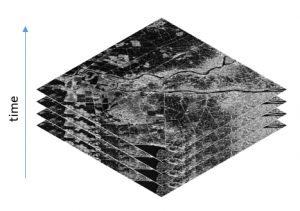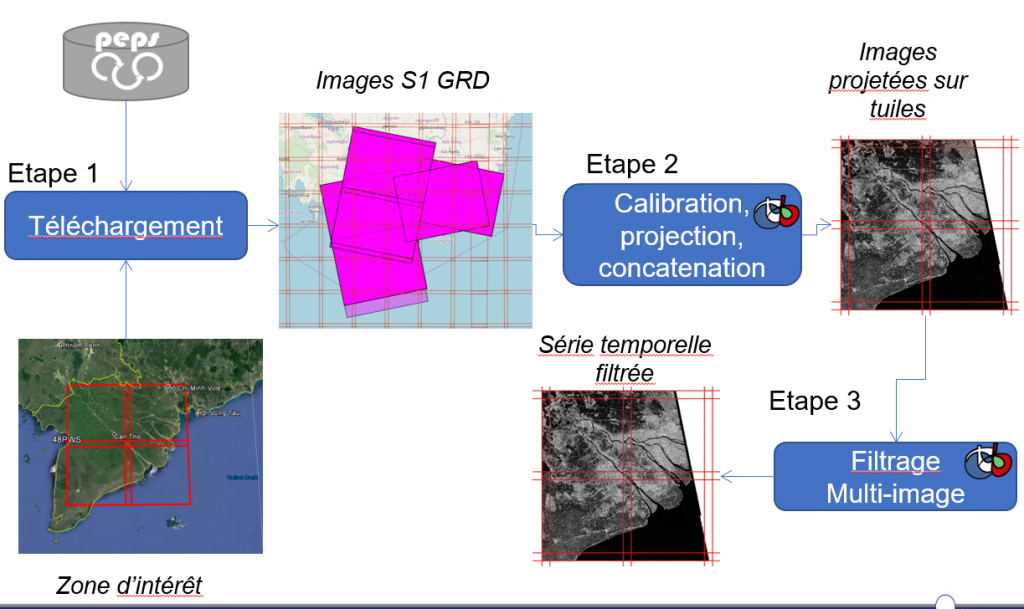![]() =>
=> ![]() Sentinel-1 is currently the only system to provide SAR images regularly on all lands on the planet. Access to these time series of images opens an extraordinary range of applications.
Sentinel-1 is currently the only system to provide SAR images regularly on all lands on the planet. Access to these time series of images opens an extraordinary range of applications. In order to meet the needs of a large number of users, including our needs, we have created an automatic processing chain to generate « Analysis Ready » time series for a very large number of applications. Sentinel-1 data is ortho-rectified on the Sentinel-2 grid to promote joint use of both missions. S1Tiling was developed within the CNES radar service, in collaboration with CESBIO, to generate time series of calibrated, ortho-rectified and filtered Sentinel-1 images on any terrestrial region of the Earth. The tool benefits for the SAR ortho-rectification application from the Orfeo Tool Box. The resulting images are registered to Sentinel-2 optical images, using the same MGRS geographic reference. You will be able to access Sentinel-1 data acquired on Sentinel-2 31TCJ or 11SPC tiles.This Python software, is based on the Orfeo Tool Box (OTB) image processing library, developed by CNES, as well as on the PEPS platform to access the Sentinel-1 data. It can be used on any type of platform, from a large computing cluster to a laptop (the fan will make some noise during processing). It is considerably faster than the ortho-rectification tool in SNAP, and can be easily used in script form. For any questions, please use the gitlab platform, rather than leaving comments to this article.
In order to meet the needs of a large number of users, including our needs, we have created an automatic processing chain to generate « Analysis Ready » time series for a very large number of applications. Sentinel-1 data is ortho-rectified on the Sentinel-2 grid to promote joint use of both missions. S1Tiling was developed within the CNES radar service, in collaboration with CESBIO, to generate time series of calibrated, ortho-rectified and filtered Sentinel-1 images on any terrestrial region of the Earth. The tool benefits for the SAR ortho-rectification application from the Orfeo Tool Box. The resulting images are registered to Sentinel-2 optical images, using the same MGRS geographic reference. You will be able to access Sentinel-1 data acquired on Sentinel-2 31TCJ or 11SPC tiles.This Python software, is based on the Orfeo Tool Box (OTB) image processing library, developed by CNES, as well as on the PEPS platform to access the Sentinel-1 data. It can be used on any type of platform, from a large computing cluster to a laptop (the fan will make some noise during processing). It is considerably faster than the ortho-rectification tool in SNAP, and can be easily used in script form. For any questions, please use the gitlab platform, rather than leaving comments to this article.
Use S1-Tiling within PEPS
If you are allergic to the command line (that’s a pity), you can use the on-demand processing features of PEPS, although it does not include the speckle filter yet. It’s very simple.
- First, connect to PEPS (https://peps.cnes.fr)

- Select the « explore » function
- Query the catalogue to obtain the images you wish to process (don’t forget to mention you want a GRD Sentinel-1 product). For each product that fits your criteria, click on the gearing icon
- go to the processing page (gearing icon, top-right)
- select Sentinel-1 ortho-rectification
- select every product and start processing
- just wait for a while


Nice work!Is there a tool equivalent to peps_maja_process.py for S-1 (i.e. peps_tiling_process.py) to submit the processing and download?Thanks
Gracias !\nLo siento, there is so far no python interface to PEPS S1 tiling. But you can install S1-tiling to process data on your own facility.\nOlivier
Thank you for this very useful code.
A simple issue :
I think in the file S1FileManager.py in the line 277 « tile_to_product_overlap_ratio » should be « TileToProductOverlapRatio ».
Thank you Sina.
You are right. The code will be upgraded/commented soon to be more useful for users and developper.
We are going to improve S1Tiling code in the next months.
Stabillity improvements and new features (incidence angle, topographic correction) are coming soon.
Dear Thierry,
Is there any news on incidence angle correction in S1Tilling code?
Do you know if it is included somewhere in the calibration processing step of OTB 7.2?
It’s being developed right now ! Email Thierry to have a schedule.
Thank you very much for your response Thierry.
Very good news for me as I am currently trying to include the S1-tiling in my workflow. I will keep on writing my observations about the code and raise questions if you don’t mind.
The current code raises some syntax errors for the python 3x users Including :
1) ‘print’ commands that should be written as ‘print()’ command
2) » condition should be ‘!=’
3) ‘ConfigParser’ to be written as ‘configparser’
Therefore the line 60 in ‘S1Processor.py’ will be :
‘config = configparser.ConfigParser(os.environ)’
ROI_by_tiles : ALL
In the configuration file it is written that:
« If ALL is specified, the software will download all images needed for the processing (see [Processing] section) »
My observation so far is that the algorithm correctly identifies the necessary SRTMs but never downloads them. Currently I manually download the requested SRTMs and place them in the right folder an then run the code which works perfectly. I wonder if I can trigger this automatic download with the current code? If yes, how?
I think I found the answer to this question :
In S1Processor.py (line 513) it is noted that:
» We can not require both to process all tiles covered by downloaded products and download all tiles »
Then In the case where the user does not use « peps » to download S1 products, he should also provide the related SRTMs. Am I right?
If you have any questions about S1 Tiling, you can find a new forum place: https://forum.orfeo-toolbox.org/c/otb-chains/s1-tiling/11.